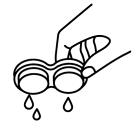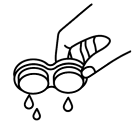Learn the best practices on how to wear and care for your contact lenses
The Wear & Care section of our website is not intended to replace or substitute the instruction sheet included in the product packaging. Please read the instruction sheet inside the box carefully before using this product.
Wearing contact lenses is safe and easy, but it does require a certain level of responsibility and proper hygiene to avoid potential risks such as
infections. Follow good wearing and cleaning instructions and the recommended replacement cycles to reduce the risks significantly.
Contact lenses are available in various types and materials for people with different eye conditions. It would be best if you visited an eye care
professional to discuss what is best suited for your needs.
Wear your Primal contacts for a maximum of 8 hours per day.
Use your Primal Contact Lenses for a maximum of 3 months.
Only use proper multipurpose contact lens solution.
Thoroughly clean your contact lens case every 2 days.
Never Top off old contact lens solution.
Replace your contact lens case every 3 months or sooner if they are damaged or dirty.
Store your contact lens in the appropriate recipient to avoid infection.
Never share your contact lenses.
Never sleep while wearing your Primal Contact Lenses.
Primal Contact Lenses are intended for customers 16 years of age or older.
Never wear damaged or unclean contact lenses.
Do not wear Primal Contact Lenses if you require medication for your eye. Consult your eye care professional.
Do not drive while wearing contact with certain shapes and designs that hide, shrink, or alter the shape of your pupil.
Do not wear contact lenses if you had a laser eye treatment unless you’ve had a lens fitting by a licensed optometrist.
Do not swim while wearing your contact lenses. Use prescription goggles instead.
Never use anything besides sterile multipurpose contact solution. Avoid using saliva or water.
Do not throw away your used lenses in the toilet or sink for environmental purposes.
Avoid environments that are extremely dry, dusty, handling of harmful chemicals substances, exposure to moisture, or extreme change in temperature.
Do not use it if the sterile blister package is opened or damaged or the lens is dry.
Always apply make up after contact has been put in your eyes.
Never use tweezers or other tools to handle your contact lenses as they can damage them.
Do not get soaps, lotions, cosmetics, sprays or deodorants in contact with your eye or contact lenses
Putting in your contact lenses may seem daunting for beginners, and you may need some help at first. However, the process becomes straightforward and effortless once you get used to it.
It's important that you follow proper instructions when handling your contacts. Avoiding the safety precautions can result in eye infections and other complications that negatively affect your vision.
Before opening the lens case, Inspect for tears, leaks, or physical defects. Do not use it if the sterile blister package is opened or damaged.
Wash your hands and dry them off with a lint-free towel before you handle your contacts. Do not get soaps, lotions, cosmetics, sprays or deodorants in contact with your eye or contact lenses.
Use the padding of your fingertips to lift your contacts from your lens case.
Place the lens in your palm and gently rinse it with a fresh multipurpose solution.
Avoid having your contact lenses come in contact with your fingernails, they can cause tears.
Use Fingertips to handle your contacts.
Thoroughly inspect the shape of your contacts and ensure they’re not inside out.
Use the non-dominant hand to hold your eyelid.
Hold the Eyelid as You Insert Contacts.
Look up at the ceiling so you are less likely to blink.
Release the eyelid and blink a few times and your lenses align in the center.
Discard the old solution, then leave it to dry after a thorough clean-up.
Use Re-wetting eye drops if you suffer from Dry Eyes.
Only use the Proper multipurpose solution.
Always handle your contacts with clean hands and store them in their designated case. If you encounter any challenges or discomfort while inserting your contact lenses, it is best to consult with your eye doctor.
Knowing how to take off your contact lenses is more important than knowing how to put them in. Simply because if you are wearing contacts and you feel any discomfort, you want to take them out right away. It's better to learn and familiarize yourself with the steps to remove your contact lenses in an emergency.
Wash your hands and dry them off with a lint-free towel before you handle your contacts.
Use the non-dominant hand to hold your eyelid.
Use the index finger and thumb of your dominant hand to pinch the lens and take it out.
Place the lens in the palm of your hand and rub it with a few drops of fresh contact lens solution.
After rubbing the lens, rinse it off to get rid of any extra debris and bacteria that may be resting on the lens.
Discard the old solution, then leave it to dry after a thorough clean-up.
Discard the old solution, then leave it to dry after a thorough clean-up.
Fill the lens case with fresh solution, with enough to submerge the lens completely.
Only use the Proper multipurpose solution.
Keep your lenses at room temperature (15-25 Celsius).
Always handle your contacts with clean hands and store them in their designated case. If you encounter any challenges or discomfort while inserting your contact lenses, it is best to consult with your eye doctor.
-Stinging, burning, itching (irritation) or other eye discomfort.
-Excessive watering, unusual eye secretions or redness of the eye.
-Poor vision, blurred vision, rainbows or halos around objects, sensitivity to light (photophobia).
- If any of the above symptoms occur immediately remove the lenses.
- If the problem stops,examine the lens carefully
- If the lens is damaged, do not put the lens back on the eye. Place the lens in the storage container and contact us immediately.
- If the lens has a foreign material on it or the problem stops and the lens appears undamaged, thoroughly clean the lens, rinse and reinsert. After reinsertion, if the problems continue immediately, remove the lenses and consult your Eye Care Professional.
Wash your hands: Thoroughly wash your hands with soap and dry them with a lint-free towel to avoid transferring debris and bacteria to your lenses. Also, avoid using oil or lotion-based soaps, as they can leave residue on your hands that can transfer to your lenses.
Keep contact lenses away from moisture: Store your contact lenses in a clean and dry lens when not in use. Also, avoid keeping your lenses where they can be exposed to moisture. Moisture can cause bacterial growth, which leads to eye infections.
Properly clean your lenses: It is important to regularly clean and disinfect your contact lenses to remove dirt, debris, and bacteria that can accumulate over time. Follow the instructions provided by your eye doctor or the lens manufacturer for the proper cleaning and disinfection process.
Use prescribed lens solution: Use only the recommended contact lens solution to clean, rinse, and disinfect your contact lenses. NEVER use saliva or tap water to clean your contact lens.
Avoid expired solutions: Once the contact lens solution expires, it loses its disinfecting qualities and can not clean your contacts.
Follow recommended wear time: Never wear your contact lenses beyond the recommended duration, or sleep in them. Contact lenses create a barrier and reduce oxygen flow to your cornea.
Don't sleep in your contacts: Sleeping in contact lenses can increase the risk of eye infections and reduce the flow of oxygen by creating a later between the conjunctiva and cornea. Make sure to remove your lenses before bed and follow the recommended wearing time prescribed by your lens care professional.
Follow the replacement cycles: Regularly replace your old contacts and the lens case to avoid protein buildup. Many eye doctors recommend replacing your lens case along with your monthly contacts.
Never shower or swim with contacts: Water carries bacteria that will stick to your contact lenses and cause infections. Never swim or shower with your contacts because it will lead to bacterial infections.
Avoid defected contacts: Don't wear contacts if they are damaged, torn, or defected; Inspect the lenses thoroughly to avoid causing damage to your eyes.
Avoid contacts on red eyes: Don't wear contacts if your eyes are red, irritated or painful because they can further reduce the oxygen flow and negatively affect the irritation.
Never share your contacts: Sharing your contact lenses can lead to the transfer of bacterial infections and possible damage to your cornea.
Contacts before makeup: Wear your contact lenses before applying your makeup, hand cream, or face lotion to avoid transferring it to your hands. Also, remember to remove your contacts before you clean your makeup to avoid having those particles sticking to your lens.
Be prepared: Needless to say, you should always be prepared in case your contact lenses cause irritation, and you have to take them out. Carry a backup pair of glasses and lens rewetting drops for emergencies.
Follow up with your optometrist: Never forget that contact lenses are considered medical devices. Visit your optometrist regularly, even if you are not experiencing any problems. Maintaining optimal eye health is important, and your eye doctor can recommend proper care.
Before you start wearing contact lenses, a comprehensive eye exam is absolutely necessary from an eye professional. An eye exam will help your doctor evaluate the health of your eyes, determine your prescription, and prescribe the type of lenses best suited for you.
For contact lens wearers, it is recommended to have an eye exam every year or as often as your eye doctor recommends. This is important to monitor any changes in your eye health and prescription and to ensure that your contact lenses continue to be the best option for your eyes.
Contact lenses are considered medical devices in the USA and requires a valid prescription from an eye care professional. A copy of your prescription will be mandatory to purchase any contact lenses on our website. A prescription generally specifies the refractive power of the lens needed, the base curve of your cornea, and the diameter of the lens best suited for your eyes. If you are living in the USA and don't have a valid prescription, we recommend to schedule yearly check-ups with your eye doctor to monitor your eye health and ensure your contact lens prescription remains up to date.
While contact lenses are an excellent alternative to prescription glasses, some individuals may not be suitable candidates for contact lens wear.
Contraindications (reasons not to use)
Do not use PRIMAL contact lenses when any of the following conditions exist:
- Inflammation or infection in or around the eye or eyelids.
- Any eye disease, injury, or abnormality that affects the cornea, conjunctiva, or eyelids.
- Any previous diagnosed condition that makes contact lens wear uncomfortable.
- Any systemic disease that may affect the eye or be exaggerated by wearing contact lenses
- Allergic reactions of ocular surfaces of the eye (adnexa) that may be induced or exaggerated by wearing contact lenses or use of contact lens solution.
- Allergic to any ingredient, such as mercury or thimerosal, in a solution wich is to be used to care for your contact lenses.
- Severe dry eye.
- Not to be used if you are unable to follow the lens care regimen or unable to obtain assistance to do so.
Should side effects occur due to the use of PRIMAL contact lenses, remove the contact lens immediately and consult your Eye Care Professional before resuming the use of contact lenses.






















































